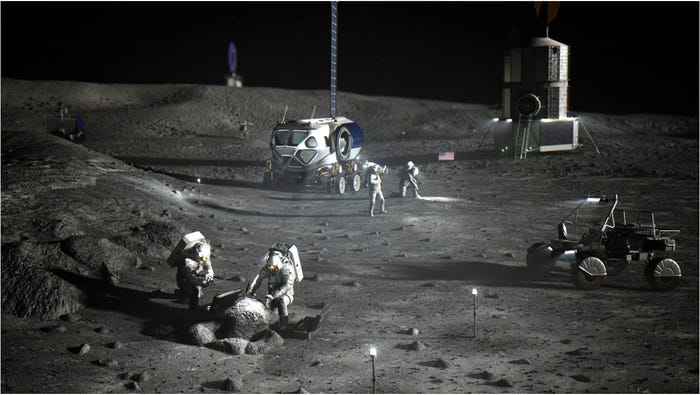By Andy Tomaswick
What happens when you cross one of the world’s largest defense contractors with one of the world’s largest automobile manufacturers? Apparently, you get an electrically powered autonomous lunar rover. At least that is the fruit of a new collaboration between Lockheed Martin (LM) and General Motors (GM).
Mobility is one of the major priorities of the Artemis program, which is set to send humans back to the moon, and provide a permanent human settlement there, by the end of the decade. Last year they released a call asking for innovative approaches to rovers. LM and GM have answered that call with a still conceptual rover that is electric, can drive itself, and can travel farther than the original lunar buggies launched with the Apollo missions in the 1970s.
Credit: General Motors YouTube Channel
That last metric is not a hard one to beat – the Apollo rovers were only capable of traveling 4 miles at a max speed of 8 miles per house. Improving on those specifications should be no challenge for the combination of LM’s space exploration nous and GM’s mobility expertise. Achieving feats that engineers 40 years ago could never have dreamed of would be different challenge though.
Two of the most interesting features of the proposed rover lean heavily on developments in the automotive industry over the last 10 years. Electrification and autonomy are buzzwords in what is slowly being rebranded as the “mobility” industry. Each would have advantages for lunar exploration missions.

Credit: NASA
Electric drive trains would either allow rovers to recharge themselves using onboard solar panels or quickly stop by a recharging station at a landing site or base for a top up before venturing out for more exploration. Solar power is relatively abundant on the moon, at least for the month when a hemisphere is facing the sun. How to charge the rovers, and the rest of any permanent settlement, for the months that their hemisphere is not pointing to the sun is a question that has yet to be answered.
Autonomy, though it faces its own challenges, is potentially the more game-changing technology. Only 5% of the lunar surface has been explored directly, and, in the beginning at least, astronauts will not have significant amounts of time to dedicate to tramping around on the surface analyzing rocks. Autonomous rovers, however, could potentially serve that role nicely, leaving on research and sample collection sorties from a central hub without requiring any input from the astronauts that are trying to build a sustainable base.

Credit: NASA
Materials those rovers might find could prove to be key components to that base. However, there is also the risk that if an autonomous driving system fails, the astronauts would have to use valuable time to go and fetch the rover itself. Surely LM and GM know how bad such a failure would look under the national spotlight of an early stage moon mission.
They might not even get the chance to prove their chops however, as the rover is still theoretical. While the corporate duo plan to use it to pitch to the Artemis program, a final selection has not been made. This appears to be GM’s first foray into space exploration, but LM hasn’t been as successful as usual in pitching their programs to NASA, having recently been edged out by SpaceX to build the Artemis program’s landing vehicle.
Credit: Lockeheed Martin YouTube Channel
Surely GM and LM will not be the only options available for any such rover program either. But if the concepts contained in their proposed system do come to fruition, it would mean a giant leap in our ability to explore our closest neighbor.
Learn More:
LM – Lockheed Martin, General Motors Team to Further Lunar Exploration with Autonomous Moon Rover
NBC – GM, Lockheed Martin developing a next-generation lunar rover
Space.com – Lockheed Martin, GM team up to build new astronaut moon buggy
Verge – Lockheed Martin and GM are working on an electric Moon buggy
Lead Image:
Visualization of astronauts next to a new generation of lunar rover.
Credit: Lockheed Martin
The post Self-Driving Lunar Rovers for Astronaut Road Trips on the Moon appeared first on Universe Today.

May 30, 2021 at 04:59PM
via Universe Today read more...

0 Comments